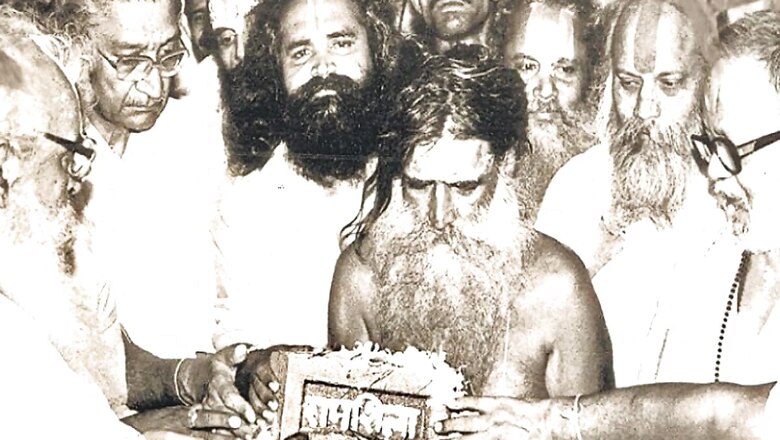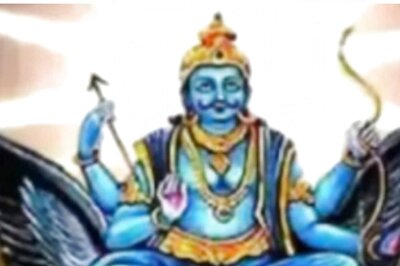Mahant Paramhans Ramchandra Das: Remembering the Seer Who Guided the Ram Temple Journey for Decades

views
On August 1, 2003, as thousands gathered on banks of the river Sarayu in Ayodhya to attend the last rites of Mahant Ramchandra Das Paramhans — sri mahant of Digambar Akhara and also president of the Ram Janmabhoomi Nyas — the skies reverberated with slogans of "Ram Lalla hum aayenge, mandir wahin banayenge". Among the dignitaries present was the-then Prime Minister Atal Bihari Vajpayee.
As heavy rain poured down, Vajpayee too reiterated the Bharatiya Janata Party's promise of a Ram temple. Seventeen years later, the time to keep that promise has come, with Prime Minister Narendra Modi laying a foundation stone of the temple, the way for which was cleared by a Supreme Court decision last year.
This is the story of that sadhu from Ayodhya, who perfectly played a seer and an activist for the "liberation of Ram Janmabhoomi" and construction of the Ram temple. A man who was highly regarded for his religious acumen as well as fierce stand on the issue of the temple. An aggressiveness that gradually earned him the title of 'Prativadi Bhayankar',meaning 'one who has the ability to give a strong and befitting reply'.
Mahant Das was born in 1913 as Chandreshwar Tiwari in a Bihar village, and moved to Ayodhya a few years later and became an ascetic with the Digambar Akhara. He was now called Paramhans Ramchandra Das.
Even in his early years as a sadhu, he was not just confined to the domain of religious pursuance.
According to historical records in public domain and the volumes of writings on the subject, Das was the city president of the Hindu Mahasabha in Faizabad during the time of India's independence in 1947.
He was occupying this office at the time when the idol of Ram Lalla was placed under the central dome of the Babri Masjid in Ayodhya on the intervening night of December 22 and 23 in 1949, By that time, he was also in close contact with Mahant Digvijay Nath, the head of the Gorakhnath Peeth of Gorakhpur. This is the same 'math', or religious community, whose chief Yogi Adityanath is now the chief minister of Uttar Pradesh.
Digvijay Nath and under him the Gorakhnath Peeth had already become a strong centre of right-wing politics. Historical material available shows Mahant Paramhans Das was in close contact with the chief mahant of the Gorakhnath Peeth, as far as the issue of Ram Janmabhoomi and Babri Masjid was concerned.
The role of Mahant Paramhans Das in the events leading to the appearance of Lord Ram's idol inside the mosque in December 1949 has been a matter of intense debate. Though the first FIR, filed at 9am on December 23, just hours after the incident, didn’t name Ramchandra Das, it had the names of a few of his acquaintances – Abhiram Das, Ramsakal Das, Sudarshan Das – and around 50 other unidentified people. Abhiram too was associated with the Hindu Mahasabha.
Though Paramhans Ramchandra Das was never formally accused in the case, years later he claimed to have executed the event of December 1949 that remains one of the biggest turning points in the dispute. It was only after the idol was placed inside that Babri Masjid was officially declared a “disputed site”. Its main gate was closed and Muslims were barred from offering namaz at the place, even while Hindus got the right to a darshan (viewing) from a side gate.
It was 1991, when Ramchandra Das told the New York Times: “I am the very man who put the idol inside the masjid.” However, in the years that followed, he largely maintained silence on his role. Even if there remains ambiguity over his actions, in his lifetime he became the most-prized saint in the Vishva Hindu Parishad (VHP) and Bharatiya Janata Party (BJP)’s scheme of things as the two stoked the temple movement.
In 1984, as the VHP attempted to spearhead the Ram Mandir campaign by organising its first dharma sansad (religious parliament), Das was a key participant. It was under the supervision of the saffron group that the Ram Janmabhoomi Nyas was later formed and Das went on to become its president. He held this post till his death.
During the heyday of the temple movement he remained one of the most crucial voices from among the saints and seers in Ayodhya, extending support to every call of agitation made by the VHP. In February 1986, as the locks of Babri Masjid were opened by court order and legal suits were transferred from Faizabad to the Lucknow bench of the Allahabad high court, Das too filed a suit in the HC, but it was withdrawn later, paving the way for another suit filed by Ram Lalla Virajman through the deity’s “sakha” (friend) Deoki Nandan Agarwal, a retired high court judge and vice-president of the VHP.
But his staunch right-wing Hindutva ideology didn't forbid Das from having cordial relations with others in Ayodhya. Stories of him riding to court along with Hashim Ansari, the-then litigant for the Babri Masjid, are still recalled.
VHP spokesperson Sharad Sharma as a young teenager had the opportunity to work closely with Mahant Das. "Despite ideological and political differences, he shared special relations with people from other religions or castes in Ayodhya," he recalled. "His good relations with Hashim Ansari were well known."
After the demolition of Babri Masjid in 1992, as Ayodhya was neglected and the BJP was accused of forgetting the Ram temple issue, Paramhans Das slightly lost the centre stage. He was also shadowed by increasing age.
Till the last days of his life, he kept on pushing for the cause of the Ram temple, an issue that was closest to his heart. But as the matter remained stuck in courts, not much could be done even as the BJP under Vajpayee went on to have its first five-year government at the Centre.
Today as Ayodhya gears up for a new start with the construction of the Ram temple commencing, Paramhans Das is being remembered by many. At a time when key architects of the movement have found space on hoardings and billboards in Ayodhya, Das has not been forgotten.
His pictures have been displayed with prominence at major spots, from the Ram Janmabhoomi complex to Kar Sevak Puram and Ram Mandir Karyashala.
(The story is Part 6 of a series on Ayodhya's Ram Temple which is set for a grand 'Bhoomi Poojan' on August 5)




















Comments
0 comment